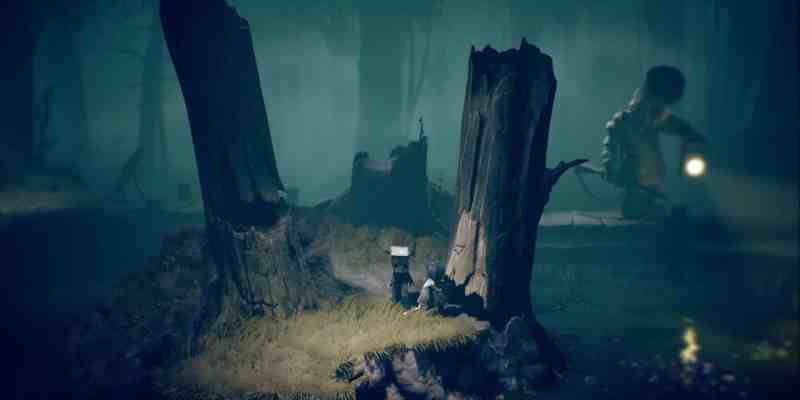This article contains spoilers for Little Nightmares II.
I was watching a horror movie the other week called The Dark and the Wicked. It has a pretty standard but effective premise — a pair of siblings return to their childhood farmhouse to take care of their ailing parents, unaware of the demonic presence that’s crept in. The whole movie is a tight, effective descent into terror. But there’s one scene that’s stuck with me ever since the night I watched it: The mom is alone in the kitchen, chopping vegetables under a dim overhead light. The metronomic sound of the knife slicing effortlessly through carrots, making contact with the wooden cutting board, and then repeating fills the air. Her eyes start to glaze over as she stares a thousand yards into the distance. The camera keeps focusing on the knife, the carrots, and how close it’s all coming to her fingers.
You can probably guess what happened next.
While watching that scene, I began to lean back on my couch. I knew what was coming, had no way of preventing it, but nonetheless felt like adding an extra six inches of distance between myself and the television screen would somehow protect me from the violence that was about to occur. Like that extra safety buffer would keep me from suffering a similar fate.
That’s the exact way I spent my time playing through Little Nightmares II — constantly leaning backwards out of subconscious fear that I’d be somehow sucked into the grim, gruesome, and fascinating world that developer Tarsier Studios has expanded upon for its sequel. The entire world unfolds like a series of morbid dioramas that have somehow put a spell on the player. But despite this visceral reaction, the awful, horrible scenes you play through are utterly compelling and impossible to look away from.

The original game was set primarily in the claustrophobic bowels of The Maw, a vessel out at sea that takes small, frail creatures like yourself and serves them up as dinner to the gluttonous horde of bulbous bourgeoisie visitors. The sequel, meanwhile, pulls the lens out and expands on the world in every way imaginable. Your journey as new character Mono takes you from dangerous forests, to terrifying schools, to sprawling dystopian cityscapes, and eventually to a giant Signal Tower that looms over everything. Where the first game felt very much like escaping your prison and moving away from a place, Little Nightmares II is built on forward momentum.
Your size in the world plays a major role in creating an evocative atmosphere. Standard keys are the size of your torso, regular chairs have to be climbed upon, and you need your entire body weight to open any door. This sense of scale evokes terror. The Hunter’s field, an early area in the game, is littered with bear traps larger than your body. Using acorns to set them off results in a violent snap, a glimpse of what it would look like if you took one wrong step. Right from the get-go, you’re presented as a frail and vulnerable creature in a world out to destroy you.
But just because you’re small, that doesn’t mean you’re powerless. The focus on size also factors into the new inclusion of weapons that you can find throughout the environment. These mostly come in the form of standard sledgehammers and axes, but to Mono, they’re gargantuan. You can feel their size and weight as you drag them slowly behind you. Each swing of an axe to chop down a wooden barrier feels like a Herculean task. And the way your sledgehammer shatters the heads of the porcelain doll students who chase you throughout the school unfolds with sickening force. I knew I needed to use these tools in order to survive and press on, but I genuinely breathed a sigh of relief whenever I was able to drop them. The violence they helped me create somehow felt cursed. Like the way Six would devour increasingly disgusting things in the original game, the acts I was forced to commit in order to survive in Little Nightmares II seemed to drain away my humanity, bit by bit.

But I wasn’t the only violent thing in the world of Little Nightmares II. Like in the original, each major area of the game is home to some central, terrifying figure that acts as the lord of that land. There’s the Hunter who stalks his fields, burlap sack on head and shotgun in hand. Or the Teacher, whose neck stretches and bends like a serpent as she scours every corner of the room in search of where you might be hiding. Their massive stature and grotesque appearance make each encounter with them a genuinely horrific experience.
However, what managed to crawl under my skin the most were the cobbled-together mannequins that would shamble towards you unless you were pointing your flashlight directly at them. It takes the playful core of a childhood game like “red light, green light” and adds a layer of abject terror to it. As the name implies, both games excel at presenting the horrors of the world through the lens of a child.
Of course, one of the big standouts in Little Nightmares II, and perhaps the biggest way it expands the world and evolves the gameplay from the original, comes from the fact that you’re not going through it all alone. For most of the game, you’re accompanied by Six, the character you played as in the first game. The relationship with Mono and Six reminded me a lot of that of Ico and Yorda in Ico for PlayStation 2, but with the added bonus of your having a stronger bond with Six from having played as her in the original game. Her survival skills and keen instincts make sense here, because they were your survival skills and your keen instinct.
The companionship makes the oppressive world a bit less lonely, but at the same time it adds a layer of tension to the sneaking sections, like when the two of you are hiding in the tall grass from the aforementioned Hunter. It’s not just you you’re worried about, but your companion as well. And when Six gets snatched away at a certain point in the story, I was that much more motivated to press on and find her. Having grown accustomed to my traveling partner meant that the moments where we were separated made me feel so much more lonely and vulnerable. And without going into specifics, the sequel builds a mechanic where you help each other cross large gaps, and it wisely subverts those expectations at a certain point for what was the most powerful moment of the game for me.

While the first game leaned heavily into the visceral disgust of rotten meat, decaying flesh, and bulbous binge-eaters, Little Nightmares II explores a more technological side of this dystopia. As Mono and Six get closer to their goal, the game leans heavier into its recurring visual motif of televisions blasting out static. Each time I came across these, it recalled the opening line of the book Neuromancer, in which William Gibson wrote, “The sky above the port was the color of television, tuned to a dead channel.”
The drone-like citizens of the Pale City are infatuated by the hum of the screens, and you can use that to your advantage as distractions in a handful of puzzles. But like everything else in Little Nightmares, this turns a terrifying corner when the allure of a glowing TV causes one of the people to run straight off a ledge to their death. Like back when I was using my sledgehammers to crash in the porcelain skulls, I kept asking myself, “Am I doing the right thing here?”
And wisely, the game doesn’t explicitly answer that question. While something like The Medium is filled with flashbacks, narration, documents, and exposition to fill you in on the generation-spanning story, Little Nightmares II is perfectly fine with letting you put in the work in order to understand its story, how it relates to the original game, and just what its surprising conclusion means for everything that came before it — and whatever might come after. If anything, Little Nightmares II comes across as an extended and effective vibe. It’s an awful, horrible, and cruel world where I constantly found myself physically leaning away, while never being able to take my eyes off it.
